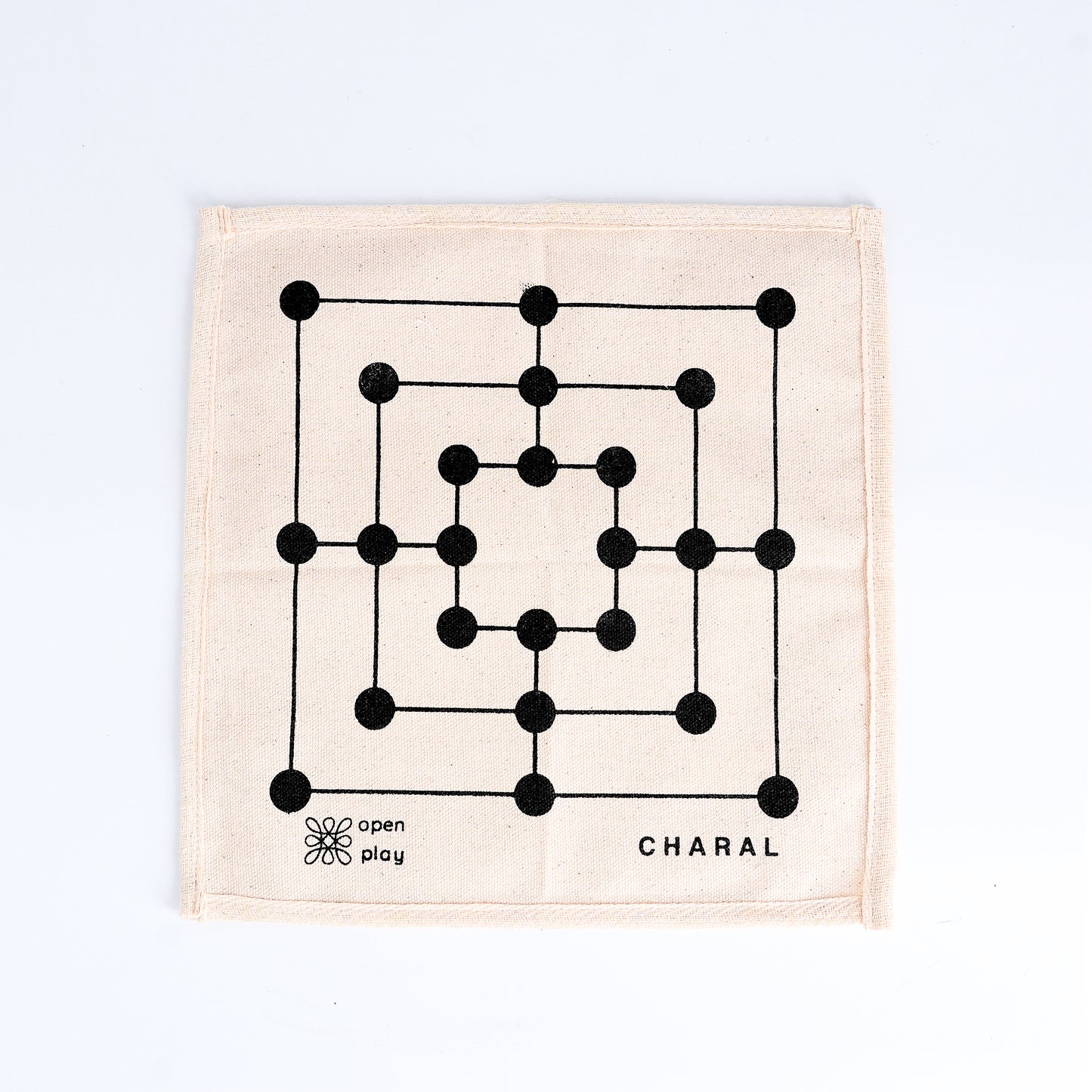Open Play
Charal + Tic-Tac-Toe
Charal + Tic-Tac-Toe
Couldn't load pickup availability
Shipping and Packaging
Shipping and Packaging
- Weight: 150gm
- Dimensions: pouch 6 x 6 inches | Mat 8.5 x 8.5 inches
- Contents: 1 pouch consisting of a game printed on the back, 1 game mat, tokens, a game rule card with a QR code
- Shipping Timeframe: 5-7 business days
- Shipping Cost: included in MRP
- International Shipping: No
The packet weighs 150 grams, and the product price includes shipping and handling. The estimated shipping time is 5–7 days business days.
Charal
Charal is well known as Nine Men's Morris or Mills in the Western world. The game is also called- "Navakankari" which is the Sanskrit name which means nine pebbles. It is known as Saalu Mane Ata or Jodpi Ata or Char-Par in Kannada, Navakankari in Gujarati and Daadi in Telugu. This is an alignment game played by 2 players. Each player gets 9 nine pawns. The game is played on a board consisting of three concentric squares connected by lines from the middle of each of the inner square's sides to the middle of the corresponding outer square's side. Pieces are played on the points where two or more lines meet or intersect, so there are 24 playable points. This is a two-player game and each player gets 9 markers of different colours.
Contents
Game board – 1 Pawns - 9 +9
Preparation and Objective
The basic aim of a player is to make 'Mills' - vertical or horizontal lines of three markers of the same colour. Every time this is achieved, an opponent's piece is removed, the overall objective is to reduce the number of opponent's markers to 'two' or to block all moves of the opponent thus rendering the opponent unable to play.
How to play
I. To begin with the board is empty.
II. markers have to be placed only on intersections of lines (shown by black dots in Fig. 1). During a turn only one marker has to be played.
III. Players toss a marker to decide who plays first and has a slight advantage as a result. Play is in two phases.
Phase I
I. To begin with, players alternately place one of their markers on any unoccupied point on the board.
II. A player has to place a marker such that he can make a 'Mill' or block the opponent from making a Mill.
III. A Mill is a formation of three markers of a player in a line either horizontally (Fig.2 & Fig.4) or vertically (Fig.3)
IV. Mill is not formed when markers are not on a connected straight line (Fig. 5, Fig.6 & Fig. 7)
V. marker from the board which was not part of a Mill. markers in a Mill are safe and cannot be removed. markers that are not in a Mill are unsafe.
VI. The player has to strategically remove such a marker of the opponent which would have helped the opponent in making a Mill in future.
VII. A marker once removed from the board cannot be placed again on the board.11. Phase 1 ends when all 18 markers have been placed on the board by players.
Phase II
I. After placing all markers on the board, players start moving their markers. During a turn only one marker has to move (in any possible direction) to an adjacent empty point which is connected to its current point by a line (See following)
II. A marker cannot jump any marker or point (Fig.11). A marker cannot move to a point if (a) that point is not connected to its present point by a straight line or (b) the point is not empty.
III. The player tries to either create a Mill and remove the opponent's one marker or block the opponent's Mill.
IV. A player can make as many Mills as possible with his markers.
V. A Mill can be broken by its owner by moving one of its three markers. During another turn the player can remake the same Mill by moving back that same marker and remove an opponent's marker.
VI. A player can capture the maximum of 3 opponent's markers by making and remaking any particular Mill, once when it is first made and one each when it is broken and remade twice. Further breaking and remaking of that particular Mill will not empower the player to remove any of the opponent's markers.
VII. A player loses the game when he is left with only two markers or when he cannot move any of his markers.
Benefits: This is an exciting game that helps develop strategy and planning.
- - - - - - - - - - - - - - - - - - - - - - - - - - - - - - - - - - - - - - -
Tic-Tac-Toe
Tic-Tac-Toe is a classic two-player strategy game where players take turns placing tokens on a 3×3 grid. The game tests logical thinking and pattern recognition, with the objective of forming a row of three matching tokens before the opponent.
Contents
1 game board (a 3×3 grid)
2 sets of tokens (3 of each)
How to Play
I. Players decide who goes first by mutual agreement or by flipping a coin.
II. The first player chooses their token colour and places one token on any empty space.
III. Players take turns placing their tokens in an unoccupied space on the board. Once a token is placed, it cannot be moved.
IV. A player wins by forming a row of three matching tokens in any of the following ways:
a. Horizontally (a full row)
b. Vertically (a full column)
c. Diagonally (from corner to opposite corner)
V. If all spaces are filled and neither player has formed a row of three, the game ends in a draw.
Share












